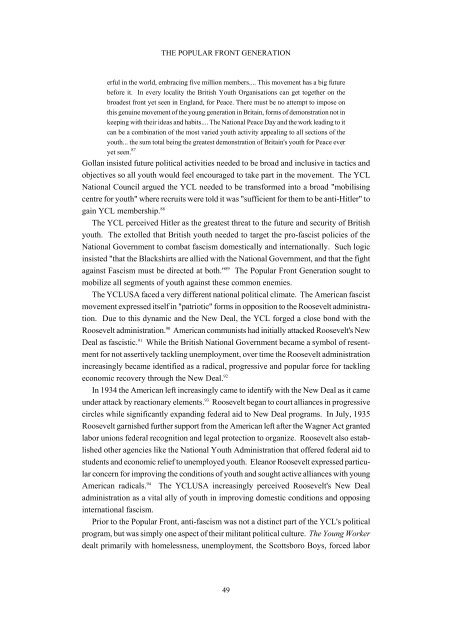Joel A Lewis Youth Against Fascism.pdf
Joel A Lewis Youth Against Fascism.pdf
Joel A Lewis Youth Against Fascism.pdf
You also want an ePaper? Increase the reach of your titles
YUMPU automatically turns print PDFs into web optimized ePapers that Google loves.
THE POPULAR FRONT GENERATION<br />
erful in the world, embracing five million members.... This movement has a big future<br />
before it. In every locality the British <strong>Youth</strong> Organisations can get together on the<br />
broadest front yet seen in England, for Peace. There must be no attempt to impose on<br />
this genuine movement of the young generation in Britain, forms of demonstration not in<br />
keeping with their ideas and habits.... The National Peace Day and the work leading to it<br />
can be a combination of the most varied youth activity appealing to all sections of the<br />
youth... the sum total being the greatest demonstration of Britain's youth for Peace ever<br />
yet seen. 87<br />
Gollan insisted future political activities needed to be broad and inclusive in tactics and<br />
objectives so all youth would feel encouraged to take part in the movement. The YCL<br />
National Council argued the YCL needed to be transformed into a broad "mobilising<br />
centre for youth" where recruits were told it was "sufficient for them to be anti-Hitler" to<br />
gain YCL membership. 88<br />
The YCL perceived Hitler as the greatest threat to the future and security of British<br />
youth. The extolled that British youth needed to target the pro-fascist policies of the<br />
National Government to combat fascism domestically and internationally. Such logic<br />
insisted "that the Blackshirts are allied with the National Government, and that the fight<br />
against <strong>Fascism</strong> must be directed at both." 89 The Popular Front Generation sought to<br />
mobilize all segments of youth against these common enemies.<br />
The YCLUSA faced a very different national political climate. The American fascist<br />
movement expressed itself in "patriotic" forms in opposition to the Roosevelt administration.<br />
Due to this dynamic and the New Deal, the YCL forged a close bond with the<br />
Roosevelt administration. 90 American communists had initially attacked Roosevelt's New<br />
Deal as fascistic. 91 While the British National Government became a symbol of resentment<br />
for not assertively tackling unemployment, over time the Roosevelt administration<br />
increasingly became identified as a radical, progressive and popular force for tackling<br />
economic recovery through the New Deal. 92<br />
In 1934 the American left increasingly came to identify with the New Deal as it came<br />
under attack by reactionary elements. 93 Roosevelt began to court alliances in progressive<br />
circles while significantly expanding federal aid to New Deal programs. In July, 1935<br />
Roosevelt garnished further support from the American left after the Wagner Act granted<br />
labor unions federal recognition and legal protection to organize. Roosevelt also established<br />
other agencies like the National <strong>Youth</strong> Administration that offered federal aid to<br />
students and economic relief to unemployed youth. Eleanor Roosevelt expressed particular<br />
concern for improving the conditions of youth and sought active alliances with young<br />
American radicals. 94 The YCLUSA increasingly perceived Roosevelt's New Deal<br />
administration as a vital ally of youth in improving domestic conditions and opposing<br />
international fascism.<br />
Prior to the Popular Front, anti-fascism was not a distinct part of the YCL's political<br />
program, but was simply one aspect of their militant political culture. The Young Worker<br />
dealt primarily with homelessness, unemployment, the Scottsboro Boys, forced labor<br />
49

















